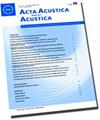声源识别的压缩球面波束形成
Q1 Arts and Humanities
引用次数: 5
摘要
本研究研究了一种压缩球形波束形成(CSB)方法,该方法使用刚性球形麦克风阵列来定位和量化源的声学贡献。该方法依赖于可表示为空间稀疏问题的阵列信号球面谐波域模型。这使得使用压缩感知通过提高稀疏性来解决未确定问题成为可能。研究了声源相对于传声器阵列的角位置估计,以及在一个体积上的三维定位。为此研究了几种稀疏恢复算法[正交匹配追踪(OMP),广义OMP, ϱ1-norm最小化和重新加权ϱ1-norm最小化]。数值和实验结果表明,稀疏恢复方法优于传统的球谐波束形成方法。重新加权ϱ1-norm对噪声有较好的适应性,提高了CSB的鲁棒性。该方法可以成功地定位源的角度位置,并量化源的相对压力贡献。该方法有望在感兴趣的三维域中定位源。然而,三维定位比二维定位对噪声、源距离和传感矩阵的特性更敏感。本文章由计算机程序翻译,如有差异,请以英文原文为准。
Compressive Spherical Beamforming for Acoustic Source Identification
This study examines a compressive spherical beamforming (CSB) method, using a rigid spherical microphone array to localize and quantify the acoustic contribution of sources. The method relies on the array signal model in the spherical harmonics domain that can be represented as a spatially
sparse problem. This makes it possible to use compressive sensing to solve an underdetermined problem via promoting sparsity. The estimation of the angular position of sources with respect to the microphone array, as well as the three-dimensional localization over a volume are investigated.
Several sparse recovery algorithms [orthogonal matching pursuit (OMP), generalized OMP, ϱ1-norm minimization, and reweighted ϱ1-norm minimization] are examined for this purpose. The numerical and experimental results indicate that sparse
recovery methods outperform conventional spherical harmonics beamforming. Reweighted ϱ1-norm has good adaptability to noise, improving the robustness of CSB. The method can successfully localize the angular position of sources, and quantify their relative pressure
contribution. The method is promising to localize sources in a three-dimensional domain of interest. However, the three-dimensional localization is more sensitive to noise, source distance, and properties of the sensing matrix than the two-dimensional localization.
求助全文
通过发布文献求助,成功后即可免费获取论文全文。
去求助
来源期刊
CiteScore
2.60
自引率
0.00%
发文量
0
审稿时长
6.8 months
期刊介绍:
Cessation. Acta Acustica united with Acustica (Acta Acust united Ac), was published together with the European Acoustics Association (EAA). It was an international, peer-reviewed journal on acoustics. It published original articles on all subjects in the field of acoustics, such as
• General Linear Acoustics, • Nonlinear Acoustics, Macrosonics, • Aeroacoustics, • Atmospheric Sound, • Underwater Sound, • Ultrasonics, • Physical Acoustics, • Structural Acoustics, • Noise Control, • Active Control, • Environmental Noise, • Building Acoustics, • Room Acoustics, • Acoustic Materials and Metamaterials, • Audio Signal Processing and Transducers, • Computational and Numerical Acoustics, • Hearing, Audiology and Psychoacoustics, • Speech,
• Musical Acoustics, • Virtual Acoustics, • Auditory Quality of Systems, • Animal Bioacoustics, • History of Acoustics.

 求助内容:
求助内容: 应助结果提醒方式:
应助结果提醒方式:


